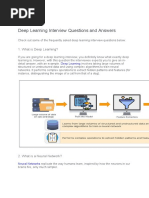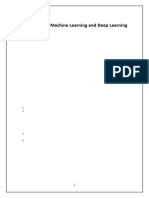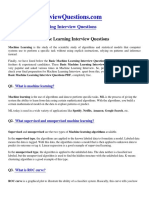0 ratings0% found this document useful (0 votes)
9 viewsPython ML Interview Questions
The document contains a list of Python machine learning interview questions and answers, covering topics such as data structures, loops, machine learning concepts, and important libraries. Key concepts include the differences between lists and tuples, types of machine learning, overfitting, and evaluation metrics. It also explains technical terms like activation functions, gradient descent, and confusion matrices.
Uploaded by
Waseem HassanCopyright
© © All Rights Reserved
Available Formats
Download as PDF, TXT or read online on Scribd
0 ratings0% found this document useful (0 votes)
9 viewsPython ML Interview Questions
The document contains a list of Python machine learning interview questions and answers, covering topics such as data structures, loops, machine learning concepts, and important libraries. Key concepts include the differences between lists and tuples, types of machine learning, overfitting, and evaluation metrics. It also explains technical terms like activation functions, gradient descent, and confusion matrices.
Uploaded by
Waseem HassanCopyright
© © All Rights Reserved
Available Formats
Download as PDF, TXT or read online on Scribd
You are on page 1/ 4
Python ML Interview Questions
1. What is the difference between list and tuple?
➢ list → changeable (mutable)
➢ tuple → can’t be changed (immutable)
2. What is a loop in Python?
➢ for loop – used to repeat things a set number of times
➢ while loop – repeats while a condition is True
3. What is the difference between is and ==?
➢ == → compares values
➢ is → compares locations in memory
4. What is a regular expression (regex)?
It’s a pattern used to search or match strings — like finding phone numbers, emails, or
words in text.
5. What is the difference between a Python list and a NumPy array?
➢ List: Slower, can hold different data types
➢ NumPy Array: Faster, used for math, holds only one data type
6. What is the difference between AI, Machine Learning, and Deep
Learning?
➢ AI (Artificial Intelligence) is when we make machines smart — like a robot that can play
chess.
➢ Machine Learning (ML) is a part of AI where machines learn from data — like a program
that learns to recognize cats in photos.
➢ Deep Learning is a part of ML that uses brain-like structures called neural networks —
great for things like voice assistants or self-driving cars.
7. What are the 3 types of Machine Learning?
➢ Supervised Learning – You give the computer both the question and the answer (like
pictures of animals with names), so it learns to guess next time.
➢ Unsupervised Learning – You only give data (no answers), and it finds patterns (like
grouping similar customers).
➢ Reinforcement Learning – The computer learns by trial and error, getting rewards or
penalties (like learning to play a video game).
8. What is overfitting and how can you avoid it?
Overfitting means your model is too smart — it memorizes the training data instead of
understanding it.
How to avoid it:
➢ Use more data
➢ Make your model simpler
➢ Use tricks like regularization, dropout, or early stopping
9. What are some important Python libraries used in AI/ML?
➢ NumPy – for numbers and arrays
➢ Pandas – for working with tables and data
➢ Matplotlib / Seaborn – for charts and graphs
➢ Scikit-learn – for basic machine learning
➢ TensorFlow / PyTorch – for deep learning (neural networks)
➢ OpenCV – for images
➢ NLTK / spaCy – for working with text (like chatbots)
10. How do you deal with missing data in a dataset?
If some values are missing:
➢ You can remove that row or column.
➢ You can fill in the missing part using the average or most common value.
➢ You can use models that can handle missing data (like XGBoost).
11. What is the bias-variance tradeoff?
➢ Bias = model is too simple → misses patterns (bad)
➢ Variance = model is too complex → memorizes training data (also bad)
➢ A good model needs a balance – not too simple, not too complex.
12. What’s the difference between classification and regression?
➢ Classification = predicting a label (e.g., spam or not spam)
➢ Regression = predicting a number (e.g., price of a house)
13. What is an activation function in neural networks?
An activation function helps the network learn complex things by adding non-linear
thinking. It decides whether a neuron should "fire" or not.
Common ones:
➢ ReLU – fast and simple
➢ Sigmoid – good for probabilities
➢ Softmax – used for multi-class classification
14. What is gradient descent?
It's a way to teach the model. It keeps adjusting the model a little at a time to make it
better — like learning by making small mistakes and correcting them.
15. What’s the difference between bagging and boosting?
➢ Bagging = train models at the same time and combine their answers (like Random
Forest).
➢ Boosting = train models one after the other, where each one tries to fix the mistakes of
the last one (like XGBoost).
16. What is a confusion matrix?
Simple Answer: It’s a table that shows how well a model did in classification.
➢ TP = Model said "Yes", and it was really "Yes"
➢ FP = Model said "Yes", but it was "No"
➢ FN = Model said "No", but it was "Yes"
➢ TN = Model said "No", and it was really "No"
17. What is one-hot encoding?
It’s a way to turn words or categories into numbers. Each category becomes a column, and
you put 1 where it belongs, 0 everywhere else.
18. How do you know if your model is good?
Use:
➢ Accuracy – how many predictions were correct
➢ Precision – how many predicted "yes" were really "yes"
➢ Recall – how many real "yes" were found
➢ F1 Score – balance of precision and recall
19. What’s the difference between shallow and deep learning?
➢ Shallow learning – uses simple models like decision trees, linear regression
➢ Deep learning – uses neural networks with many layers (great for voice, images, etc.)
20. How does a decision tree work?
It asks yes/no questions at each step to split the data. It keeps asking until it reaches a
decision.
Like:
➢ Is the color red?
➢ Is the size big?
➢ Then it's a "Truck".
You might also like
- 170 Machine Learning Interview Questios - Greatlearning100% (1)170 Machine Learning Interview Questios - Greatlearning57 pages
- Top 100 Machine Learning Questions With Answers For Interview PDF100% (3)Top 100 Machine Learning Questions With Answers For Interview PDF48 pages
- Deep Learning Interview Questions and AnswersNo ratings yetDeep Learning Interview Questions and Answers21 pages
- The Lost Art of Common Sense in - Lars Bo Hansen100% (5)The Lost Art of Common Sense in - Lars Bo Hansen35 pages
- Machine Learning and Data Science ANSWERNo ratings yetMachine Learning and Data Science ANSWER9 pages
- Twenty Frequently Asked Interview Questions and AnswersNo ratings yetTwenty Frequently Asked Interview Questions and Answers8 pages
- Data Science Important Interview Questions & Answers✅No ratings yetData Science Important Interview Questions & Answers✅19 pages
- 120 Deep Learning Important Questions + Answers ?No ratings yet120 Deep Learning Important Questions + Answers ?68 pages
- Top 100 Interview Questions On Machine Learning100% (1)Top 100 Interview Questions On Machine Learning155 pages
- Data Science Interview Questions (#Day9)No ratings yetData Science Interview Questions (#Day9)9 pages
- Class1-%20Introduction%20and%20foundation-1717413257735No ratings yetClass1-%20Introduction%20and%20foundation-171741325773523 pages
- Project Presentation Viva Question and AnswersNo ratings yetProject Presentation Viva Question and Answers4 pages
- Top 170 Machine Learning Interview Questions 2024 - Great LearningNo ratings yetTop 170 Machine Learning Interview Questions 2024 - Great Learning67 pages
- Data Science Interview QnAs by CloudyMLNo ratings yetData Science Interview QnAs by CloudyML21 pages
- Deep Learning With Python Illustrated Guide For Beginners & Intermediates: The Future Is Here!: The Future Is Here!, #2From EverandDeep Learning With Python Illustrated Guide For Beginners & Intermediates: The Future Is Here!: The Future Is Here!, #21/5 (1)
- Object Oriented Software Engineering Using UML Patterns and Java 3rd Edition by Bernd Bruegge, Allen H Dutoit ISBN 0133002098 9780133002096pdf download100% (3)Object Oriented Software Engineering Using UML Patterns and Java 3rd Edition by Bernd Bruegge, Allen H Dutoit ISBN 0133002098 9780133002096pdf download90 pages
- Gap Assessment in The Emergency Response Community: PNNL-19782No ratings yetGap Assessment in The Emergency Response Community: PNNL-1978248 pages
- Grievance Redress System (GRS) Intake FormNo ratings yetGrievance Redress System (GRS) Intake Form3 pages
- St. Jude College Phinma Education NetworkNo ratings yetSt. Jude College Phinma Education Network7 pages
- VHF 136-174Mhz High Performances Fiber Optic Repeating SystemNo ratings yetVHF 136-174Mhz High Performances Fiber Optic Repeating System4 pages
- Simon J Lock UCLSMP Townmeeting PresentationNo ratings yetSimon J Lock UCLSMP Townmeeting Presentation10 pages
- Arduino Based Automated Test Equipment (Progress Report) : Group MembersNo ratings yetArduino Based Automated Test Equipment (Progress Report) : Group Members13 pages
- NetFlow_IPFIX Exporting with pmacct – Bits 'n BytesNo ratings yetNetFlow_IPFIX Exporting with pmacct – Bits 'n Bytes6 pages
- Open Hub-Extraction of Data FRM SAP To Non SAPNo ratings yetOpen Hub-Extraction of Data FRM SAP To Non SAP10 pages

























































































